The Saucer and the Harrier
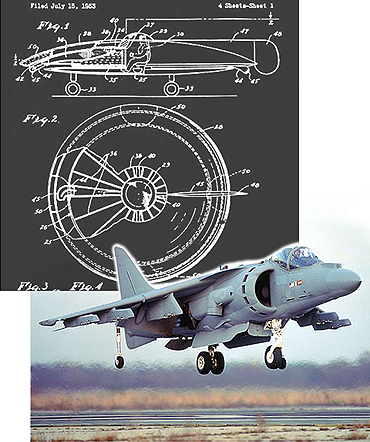
The most successful and effective jet-powered vertical takeoff and landing (VTOL) aircraft of all time is the British Aerospace Harrier. Originally conceived in the late 1950s, and deployed in the mid 1960s by the Royal Air Force, Royal Navy, US Marine Corps and other services, the Harrier was the first operational combat aircraft to combine jet fighter speed and agility with the helicopter's hovering capability. It enabled NATO to address one of its most troubling problems: how to cope with the fact that, in the first hours of a European war with the USSR, most Western front-line airbases would probably be destroyed by enemy missile strikes. Still in service over forty years after its first flight, highly developed versions of the basic Harrier design continue to form important components of US and British strike forces, and prototypes of more advanced supersonic successors, the stealthy Lockheed Martin Joint Strike Fighter, are only now in flight test.
There seems to have been a tacit assumption in the back of the minds of many UFO enthusiasts that aircraft would come to resemble "flying saucers" as they advanced and evolved. But weirdly, the Harrier is an example of the reverse phenomenon, because it actually evolved from a disc-shaped design that was born in the early 1950s, at the height of interest in man-made saucers.
It seems possible that more design effort has been expended on VTOL aircraft than any other type of winged vehicle. The promised payoff is so high, and the design challenges are so great, that every possible permutation of shape, powerplant, and thrust vectoring scheme has been advanced in the six decades since the development of jet powerplants first allowed designers to dream of fighters that were light enough to be supported by their engine thrust.
One of the basic problems confronting VTOL engineers was how to make the jet engine's thrust act through the center of gravity of the aircraft while it was hovering. The simplest way was to stand an aircraft on its tail and allow it to take off straight up like a rocket. This so-called "tailsitter" VTOL technique was feasible, and several experimental airplanes used it, but it limited the size of the aircraft and was hardly practical in combat situations, particularly when landing.
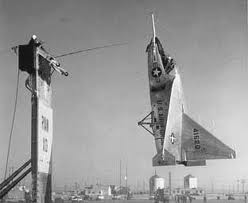 |
Ryan X-13 Vertijet "tailsitter" VTOL |
It was much more desirable to provide some way to allow a jet fighter to stay in a normal horizontal attitude during takeoff and landing, while providing some means of diverting the thrust of the jet or jets downward. One way to do this was to put an engine on each wingtip and tilt them straight up for takeoff and landing. This method was attempted by several manufacturers and was successful to a degree, but it too had practical drawbacks (such as erosion of the ground under the high-velocity jet exhaust with consequent damage to the plane and surrounding objects).
The breakthrough that led to the development of the Harrier's engine traces from the concepts of a relatively obscure French engineer named Michel Wibault, and his little-known concepts for a saucer-shaped aircraft.
Michel Wibault
Shortly after the Armistice that ended World War I, Wibault, a native of Lille, took advantage of design concepts he had developed while confined to his home during the German occupation and founded the Societe des Avions Michel Wibault near Paris. He developed many fighter and transport designs, mainly notable for being monoplanes when biplanes were still the norm, and for their use of new light-metal (Duralumin) construction.
His Wibault-Penhoet 282 transport of the early 1930s gave France a large, state-of-the art three-engine transport comparable to the German Junkers Ju 52.
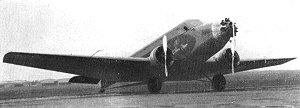 |
Wibault 282 |
In 1922 Wibault became a consultant for the British Vickers aircraft company, and apparently maintained links to British industry for many years.
During WWII, Wibault evidently came to the US and may have worked in a consulting capacity with US aviation companies in the New York City area, such as Republic Aircraft. The Republic connection is intriguing, as Alexander Kartveli, the company's chief engineer, had worked for Wibault. Born in Czarist Georgia, Kartveli had obtained his engineering degree in Paris and had worked for several French companies, including Wibault's, before emigrating to the US in the late 1920s. Little information is available concerning Wibault's work in the US in the 1945-55 period, but in the summer of 1953, Wibault suddenly filed a most interesting patent application under the name "Vibrane Corporation."
Wibault's primary concept, which he called a "Gyropter," was a saucer-shaped manned aircraft that was essentially a flying jet engine. Wibault's reason for the strange shape choice is unknown, but there are many examples of similar designs from the period, and it seems most likely that he was intrigued with the massive media coverage of the 1952 UFO wave and was attempting to develop a concept for a "flying saucer" that could actually work, if based on current technology.
The Gyropter's circular wing formed the enclosure for an immense centrifugal air compressor. Its impeller took in air via a circular inlet surrounding the pilot's cockpit bubble, compressed it, and exhausted it through an annular slot just inside the lower rim of the wing. The rotor was driven by four ducted burners that resembled a breed of small ramjets that were used at the time as a power source for experimental tip-jet helicopters. By driving the rotor via these tip jets, Wibault eliminated the weight and complexity of typical rotor drive systems using shafts and geartrains, as well as the need for anti-torque tail rotors used by most helicopters.
Aircraft with circular wings are inherently unstable in flight because their center of aerodynamic pressure is likely to be forward of their center of gravity, producing pitching forces that tend to overturn the craft. Wibault dealt with this effect through the gyroscopic force produced by the large rotating impeller. Once the rotor spun up to operating speed, the aircraft would be held in a horizontal attitude that would help resist destabilizing moments.
To control this flying gyroscope, Wibault proposed an unusual system of four interconnected fluid ballast tanks at the cardinal points of the rim of the saucer. By pumping liquid ballast, such as water, from tank to tank, the saucer's center of gravity would be adjusted and it would be slightly tipped in the direction the pilot wished to go. However, the gyroscopic couple effect meant that in order to tip the "nose" of the saucer down (which would angle the thrust to the rear and produce forward motion), ballast fluid would have to be pumped to the tank at the "left wingtip." Stability and control in the yaw plane was provided by a large vertical fin and rudder.
Since there was a limit to how far the nose of the craft could be tipped without sacrificing lift, the top speed of this aircraft was inherently restricted without use of auxiliary propulsion motors.
The pilot would be accommodated in a very cramped capsule within the hub of the compressor rotor. Looking out through a tiny bubble canopy, his downward vision was virtually nonexistent, making landings a dicey process.
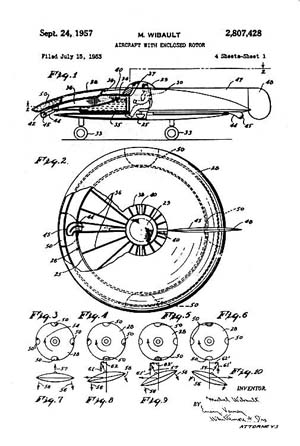 |
click to enlarge |
Wibault filed his patent application in the US on July 15, 1953, just over a month before John C M Frost of Avro Canada applied for patent protection for the Project Y "spade-shaped" VTOL jet saucer, which had been under development since about October 1951.
While the Wibault Gyropter and the Avro VTOL concept shared some major features, such as the immense compressor rotor enclosed within the wing, in most respects the Wibault saucer was cruder than Avro's super-complex design. On one hand, Avro's concept permitted the tremendous thrust of the huge engine to be used in forward flight as well as during takeoff and landing, giving it supersonic speed. On the other hand, Wibault's comparatively straightforward design permitted vertical takeoff and landing in a horizontal attitude, while the Avro saucer was a "tailsitter" and needed a special cart or complex landing gear to position it in the proper takeoff attitude.
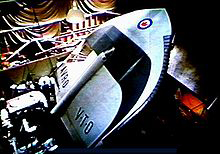 |
Avro Canada Project Y supersonic VTOL fighter concept, c. 1952 |
Perhaps more interesting than Wibault's Gyropter saucer was a modification of the design that incorporated the centrifugal impeller into a triangular flying wing. This version was clearly optimized for high speed flight, and added a compressor bleed system which produced forward thrust by diverting a fraction of the engine's airflow into a rear-facing combustion chamber.
Most of the impeller's thrust would still be used for lift, and its gyroscopic stability would remain as before, but this version could quickly accelerate from a hover to high speed, possibly supersonic, horizontal flight. Control in the hover mode continued to be based on the ballast tank system, but conventional aerodynamic controls were provided for forward flight.
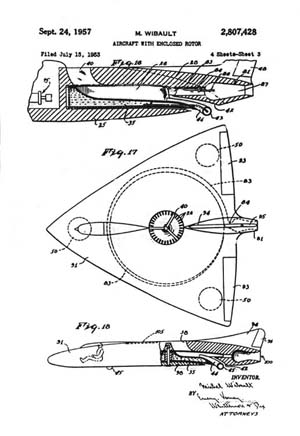 |
click to enlarge |
Wibault's patent showed various modifications of this basic design, including versions with multiple engines, and passenger models.